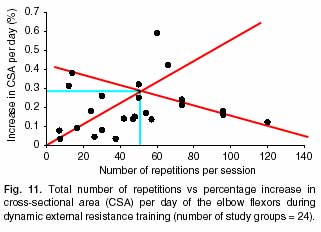scientific muscle
New Member
I have recently finished the 4 weeks 'volume phase' of Stephan Korte's powerlifting program. To make a long story short....do a crap load of sets for squats/deads and bench three times week at fairly low weight (60% of 1 rm). My thighs grew over an inch each and I was cutting and losing bodyweight at the time! They would have grown even more if I was bulking.
I cut this from my post in the SST section so I could post it here also:
<div></div><div id="QUOTEHEAD">QUOTE</div><div id="QUOTE">
I have learned first hand that VOLUME (total workload) really is a HUGE factor in hypertrophy. The loads I have been using are light (around 60% of 1 rm) but the total workload each week for the thighs is tremendous. I have never had thigh growth like this, and I was CUTTING and losing weight while they grew.
I know Dan has voiced this several times, and at hypertrophy-research.com we have discussed this several times and I am decided now from my experience that high volume is KEY to hypertrophy.
I would recommend HSTers to keep up the 3 times/week training and sticking to basic, heavy, compound exercises. But one thing I would recommend is to INCREASE TOTAL REPS PER BODYPART, if you can handle it.
For example doing a simplified HST routine:
Alternating
Day 1:Squats, Rows, Bench, Military Press.
Day 2 eadlifts, Chinups, Dips, DB Upright rows.
eadlifts, Chinups, Dips, DB Upright rows.
In this routine there are only 4 exercise per workout, I would recommend doing at least 30 reps per exercise. This means doing 2 sets of 15s, 3 sets of 10s and 6 sets of 5s. If you are doing something like 8 or more different exercises, then 15-20 reps per exercise is probably fine. (which is what Dan and Bryan usually recommend).
*PUT THAT IN YOUR PIPE AND SMOKE IT!
</div>
I cut this from my post in the SST section so I could post it here also:
<div></div><div id="QUOTEHEAD">QUOTE</div><div id="QUOTE">
I have learned first hand that VOLUME (total workload) really is a HUGE factor in hypertrophy. The loads I have been using are light (around 60% of 1 rm) but the total workload each week for the thighs is tremendous. I have never had thigh growth like this, and I was CUTTING and losing weight while they grew.
I know Dan has voiced this several times, and at hypertrophy-research.com we have discussed this several times and I am decided now from my experience that high volume is KEY to hypertrophy.
I would recommend HSTers to keep up the 3 times/week training and sticking to basic, heavy, compound exercises. But one thing I would recommend is to INCREASE TOTAL REPS PER BODYPART, if you can handle it.
For example doing a simplified HST routine:
Alternating
Day 1:Squats, Rows, Bench, Military Press.
Day 2
In this routine there are only 4 exercise per workout, I would recommend doing at least 30 reps per exercise. This means doing 2 sets of 15s, 3 sets of 10s and 6 sets of 5s. If you are doing something like 8 or more different exercises, then 15-20 reps per exercise is probably fine. (which is what Dan and Bryan usually recommend).
*PUT THAT IN YOUR PIPE AND SMOKE IT!
</div>

